The Daily Shot: 08-Nov-23
• The United States
• Canada
• The Eurozone
• Europe
• Asia-Pacific
• China
• Commodities
• Energy
• Equities
• Credit
• Rates
• Global Developments
• Food for Thought
The United States
1. Let’s begin with consumer credit.
• Growth in consumer credit was slightly below forecasts in September.

– Credit card balances increased again, …

… but are holding below pre-COVID levels when measured as a share of disposable income.

Adjusted for inflation, credit card balances edged lower.

– By the way, credit card rates remain at record highs.

– Government-held student loan balances are now down on a year-over-year basis (in part due to student debt forgiveness).

• Consumer credit delinquencies have been moving higher.

Below are the trends by age group.
 Source: Federal Reserve Bank of New York
Source: Federal Reserve Bank of New York
——————–
2. Tight bank lending standards indicate high recession odds.
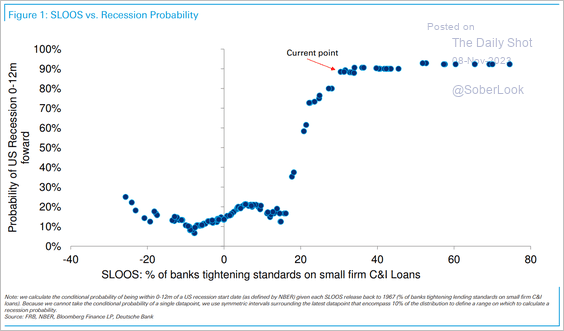 Source: Deutsche Bank Research
Source: Deutsche Bank Research
3. Goldman anticipates that the waning influence of monetary tightening on economic growth could weaken the case for Fed rate cuts next year.
 Source: Goldman Sachs
Source: Goldman Sachs
4. Wholesale used automobile prices continue to ease.

5. The trade deficit increased in September.

 Source: @economics Read full article
Source: @economics Read full article
• Both imports and exports grew.
 Source: @TheTerminal, Bloomberg Finance L.P.
Source: @TheTerminal, Bloomberg Finance L.P.
• The trade gap with China widened but remained at multi-year lows.

Here is the trade gap with Mexico.
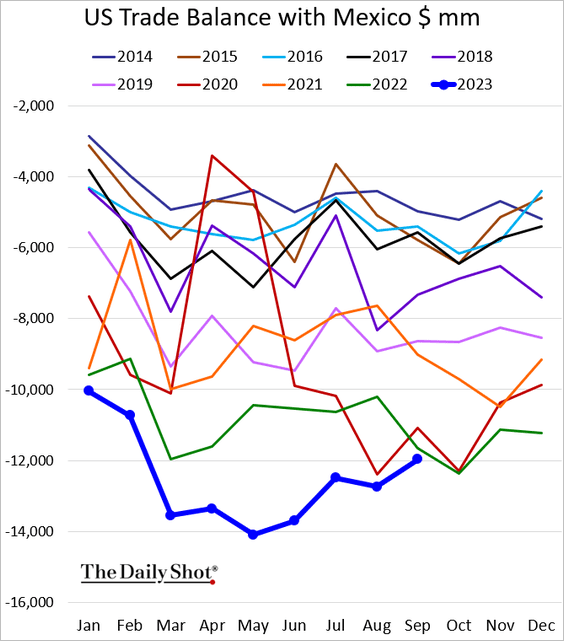
——————–
6. More companies are mentioning reshoring during earnings calls.
 Source: BofA Global Research
Source: BofA Global Research
Back to Index
Canada
1. The September trade surplus was higher than expected.

2. Roughly two-thirds of households with mortgages hold more deposits now than they did pre-pandemic.
 Source: Scotiabank Economics
Source: Scotiabank Economics
• Interest income received from both bonds and bank deposits increased in recent quarters. However, interest paid still outstrips interest income (black line), which is a net negative for Canadian consumers.
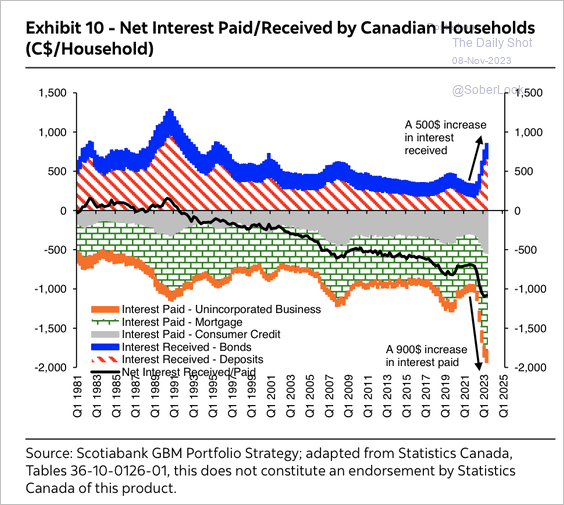 Source: Hugo Ste-Marie, Portfolio & Quantitative Strategy Global Equity Research, Scotia Capital
Source: Hugo Ste-Marie, Portfolio & Quantitative Strategy Global Equity Research, Scotia Capital
Back to Index
The Eurozone
1. Germany’s construction activity is crashing.

2. Below is the euro-area PPI (year-over-year).

3. The euro has appreciated above “weak link” currencies that are sensitive to higher interest rates like AUD, CAD, and GBP.
 Source: MRB Partners
Source: MRB Partners
4. This chart shows the year-to-date changes in electricity generation.
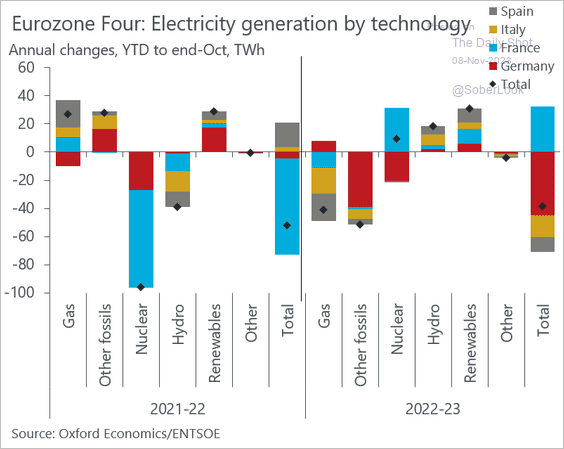 Source: @DanielKral1
Source: @DanielKral1
Back to Index
Europe
1. Norway’s industrial production registered the largest decline on record due to natural gas outages.

 Source: @economics Read full article
Source: @economics Read full article
The Norwegian krone continues to weaken, with EUR/NOK trading near 12.0 again.

——————–
2. Swden’s labor market has been softening.
 Source: ING
Source: ING
3. The Czech koruna has been sagging, with EUR/CZK maintaining the uptrend channel.
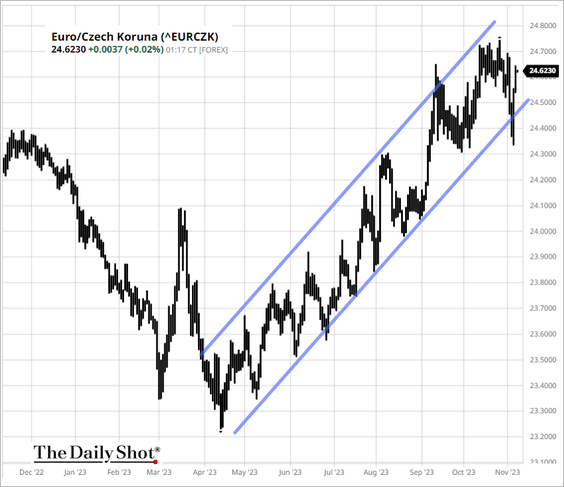
4. The EU’s foreign direct investment has been slowing.
 Source: European Commission
Source: European Commission
Back to Index
Asia-Pacific
1. Dollar-yen is holding above 150.

2. South Korea’s trade balance has been rebounding.

3. Taiwan’s trade surplus came off the highs and was below forecasts last month.

Back to Index
China
1. Foreign exchange reserves declined again.

2. Beijing is orchestrating a bailout of Country Garden …
 Source: Reuters Read full article
Source: Reuters Read full article
… which defaulted last month.

• China’s home sales remain sluggish.
 Source: @economics Read full article
Source: @economics Read full article
——————–
3. Foreigners have stepped in to buy mainland shares amid promises of more stimulus.
 Source: @markets Read full article
Source: @markets Read full article
4. The PMI data points to a rebound in producer prices.
 Source: Simon White, Bloomberg Markets Live Blog
Source: Simon White, Bloomberg Markets Live Blog
Back to Index
Commodities
1. Iron ore continues to rally.

2. Gold and oil have been highly correlated in recent days.
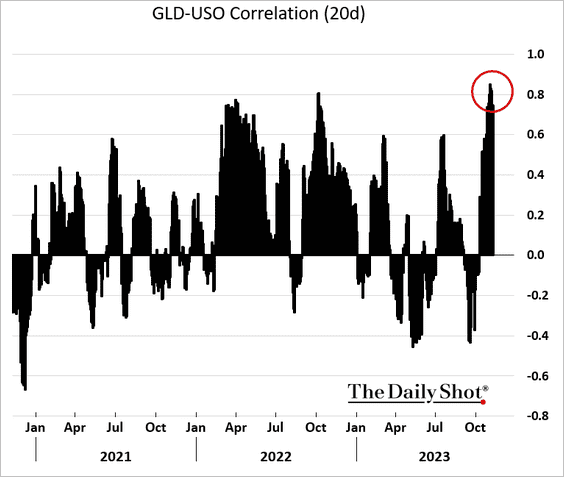 h/t Robert Fullem, Bloomberg
h/t Robert Fullem, Bloomberg
3. Forecasts suggest that the US corn crop may hit a new record, pressuring prices.

4. Chicago cattle futures fell further this week.

 Source: barchart.com Read full article
Source: barchart.com Read full article
Back to Index
Energy
1. Brent futures dipped below the 200-day moving average.

Crude oil backwardation has been narrowing amid demand concerns.

 Source: @markets Read full article
Source: @markets Read full article
——————–
2. CTAs remain bullish on crude oil.
 Source: Deutsche Bank Research
Source: Deutsche Bank Research
3. Energy shares have been under pressure in recent days.
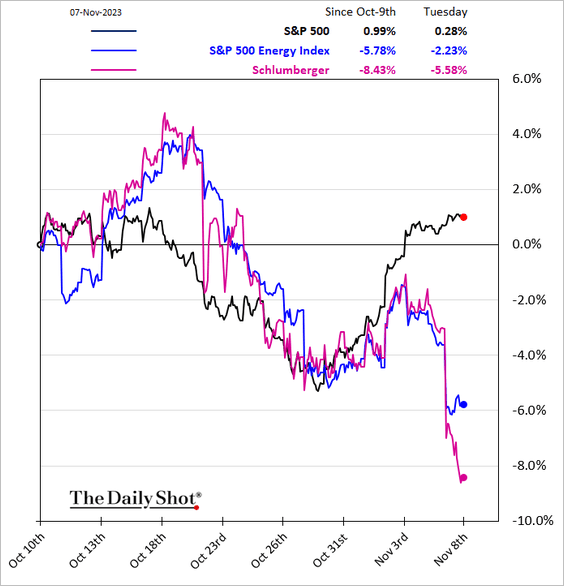
Back to Index
Equities
1. Historically, a peak in US large-cap market concentration has preceded sustained small-cap outperformance.
 Source: Goldman Sachs Asset Management
Source: Goldman Sachs Asset Management
• The Russell 2000 index held resistance at the 50-day moving average.

——————–
2. The correlation between stocks and bonds remains elevated.
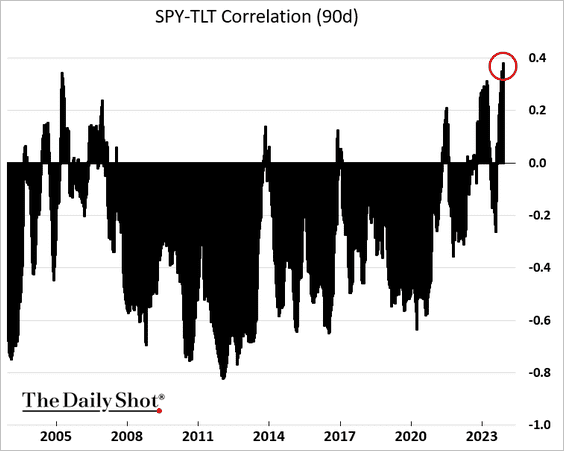
3. Fewer firms have been beating sales forecasts.
 Source: @markets Read full article
Source: @markets Read full article
Companies remain very concerned about flagging demand.
 Source: @markets Read full article
Source: @markets Read full article
——————–
4. Companies with high international exposure have been underperforming on earnings and revenue.
 Source: @FactSet Read full article
Source: @FactSet Read full article
5. Outside of the US, valuations appear to be reasonable relative to the 20-year history.
 Source: Goldman Sachs; @WallStJesus
Source: Goldman Sachs; @WallStJesus
6. On an equal-weight basis, cyclical growth stocks started to underperform over the past few months and could face additional pressure if inflation remains sticky, according to Stifel.
 Source: Stifel
Source: Stifel
Meanwhile, equal-weight cyclical value stocks appear to be near a trough relative to the S&P 500.
 Source: Stifel
Source: Stifel
——————–
7. How are long-only funds positioned in tech mega-caps?
 Source: BofA Global Research; @MikeZaccardi
Source: BofA Global Research; @MikeZaccardi
Back to Index
Credit
1. Growth in new credit applications for business loans has slowed.

2. PIK deals have been popular as sponsors try to preserve cash, but this type of financing will be very costly over the long run.
 Source: @markets Read full article
Source: @markets Read full article
3. US corporate net interest expense as a percentage of GDI declined sharply in recent years, more so than in other major economies. (2 charts)
 Source: Deutsche Bank Research
Source: Deutsche Bank Research
 Source: Deutsche Bank Research
Source: Deutsche Bank Research
——————–
4. MBS spreads remain well above IG corporate credit spreads.
 Source: Simon White, Bloomberg Markets Live Blog
Source: Simon White, Bloomberg Markets Live Blog
5. Next, we have some updates on commercial real estate.
• Credit growth:
 Source: @WSJ Read full article
Source: @WSJ Read full article
• Tightening bank underwriting standards (2 charts):


• Office-to-apartment conversion:
 Source: @WSJ Read full article
Source: @WSJ Read full article
Back to Index
Rates
1. Three consecutive years of negative treasury returns is highly unusual.
 Source: BofA Global Research
Source: BofA Global Research
2. China’s holdings of Treasuries continue to decline alongside the Fed’s QT.
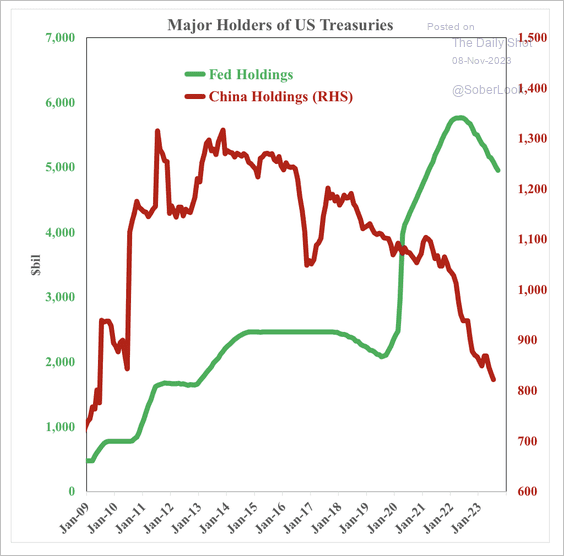 Source: SOM Macro Strategies
Source: SOM Macro Strategies
3. Demand for zero-coupon Treasuries surged last month.
 Source: @markets Read full article
Source: @markets Read full article
4. The implied return asymmetry in intermediate-duration Treasuries has significantly improved relative to the low-rate environment in 2020.
 Source: Goldman Sachs Asset Management
Source: Goldman Sachs Asset Management
5. Survey indicators point to further declines in Treasury yields.
 Source: Simon White, Bloomberg Markets Live Blog
Source: Simon White, Bloomberg Markets Live Blog
6. Millennials embrace bonds.
 Source: @johnauthers, @opinion Read full article
Source: @johnauthers, @opinion Read full article
Back to Index
Global Developments
1. Central banks’ policy rate cuts have picked up momentum.
 Source: BofA Global Research
Source: BofA Global Research
2. Here is a look at reserve assets by country.
 Source: Codera Analytics Read full article
Source: Codera Analytics Read full article
3. There are big differences across countries in dominant sources of tax revenue.
 Source: Codera Analytics Read full article
Source: Codera Analytics Read full article
——————–
Food for Thought
1. US household formation projections:
 Source: @financialtimes Read full article
Source: @financialtimes Read full article
2. Nonparticipation rates in the US labor force by generation and age:
 Source: Federal Reserve Bank of San Francisco
Source: Federal Reserve Bank of San Francisco
• Reasons for nonparticipation:
 Source: Federal Reserve Bank of San Francisco
Source: Federal Reserve Bank of San Francisco
——————–
3. Contributions to CO2 emissions:
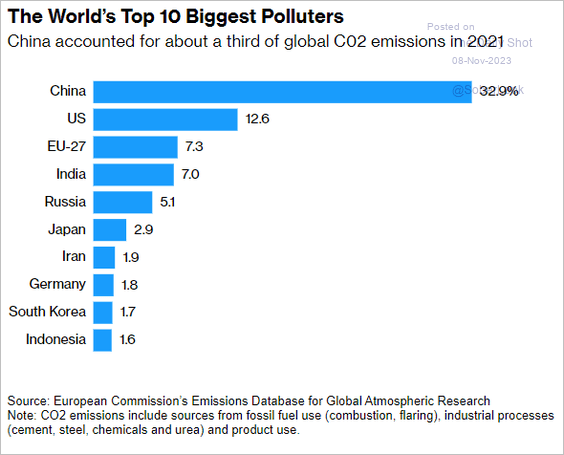 Source: @climate Read full article
Source: @climate Read full article
4. Global sea surface temperature:
 Source: Climate Reanalyzer
Source: Climate Reanalyzer
5. Views on US government agencies:
 Source: Gallup Read full article
Source: Gallup Read full article
6. Anti-Latino hate crimes:
 Source: @TheDailyShot
Source: @TheDailyShot
7. How Americans organize their book collections:
 Source: @chartrdaily
Source: @chartrdaily
——————–
Back to Index
